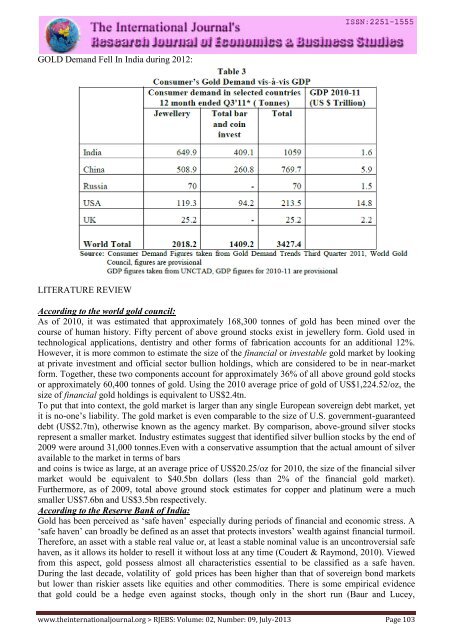Research Journal of Economics & Business Studies - RJEBS - The ...
Research Journal of Economics & Business Studies - RJEBS - The ...
Research Journal of Economics & Business Studies - RJEBS - The ...
Create successful ePaper yourself
Turn your PDF publications into a flip-book with our unique Google optimized e-Paper software.
GOLD Demand Fell In India during 2012:<br />
LITERATURE REVIEW<br />
According to the world gold council:<br />
As <strong>of</strong> 2010, it was estimated that approximately 168,300 tonnes <strong>of</strong> gold has been mined over the<br />
course <strong>of</strong> human history. Fifty percent <strong>of</strong> above ground stocks exist in jewellery form. Gold used in<br />
technological applications, dentistry and other forms <strong>of</strong> fabrication accounts for an additional 12%.<br />
However, it is more common to estimate the size <strong>of</strong> the financial or investable gold market by looking<br />
at private investment and <strong>of</strong>ficial sector bullion holdings, which are considered to be in near-market<br />
form. Together, these two components account for approximately 36% <strong>of</strong> all above ground gold stocks<br />
or approximately 60,400 tonnes <strong>of</strong> gold. Using the 2010 average price <strong>of</strong> gold <strong>of</strong> US$1,224.52/oz, the<br />
size <strong>of</strong> financial gold holdings is equivalent to US$2.4tn.<br />
To put that into context, the gold market is larger than any single European sovereign debt market, yet<br />
it is no-one’s liability. <strong>The</strong> gold market is even comparable to the size <strong>of</strong> U.S. government-guaranteed<br />
debt (US$2.7tn), otherwise known as the agency market. By comparison, above-ground silver stocks<br />
represent a smaller market. Industry estimates suggest that identified silver bullion stocks by the end <strong>of</strong><br />
2009 were around 31,000 tonnes.Even with a conservative assumption that the actual amount <strong>of</strong> silver<br />
available to the market in terms <strong>of</strong> bars<br />
and coins is twice as large, at an average price <strong>of</strong> US$20.25/oz for 2010, the size <strong>of</strong> the financial silver<br />
market would be equivalent to $40.5bn dollars (less than 2% <strong>of</strong> the financial gold market).<br />
Furthermore, as <strong>of</strong> 2009, total above ground stock estimates for copper and platinum were a much<br />
smaller US$7.6bn and US$3.5bn respectively.<br />
According to the Reserve Bank <strong>of</strong> India:<br />
Gold has been perceived as ‘safe haven’ especially during periods <strong>of</strong> financial and economic stress. A<br />
‘safe haven’ can broadly be defined as an asset that protects investors’ wealth against financial turmoil.<br />
<strong>The</strong>refore, an asset with a stable real value or, at least a stable nominal value is an uncontroversial safe<br />
haven, as it allows its holder to resell it without loss at any time (Coudert & Raymond, 2010). Viewed<br />
from this aspect, gold possess almost all characteristics essential to be classified as a safe haven.<br />
During the last decade, volatility <strong>of</strong> gold prices has been higher than that <strong>of</strong> sovereign bond markets<br />
but lower than riskier assets like equities and other commodities. <strong>The</strong>re is some empirical evidence<br />
that gold could be a hedge even against stocks, though only in the short run (Baur and Lucey,<br />
www.theinternationaljournal.org > <strong>RJEBS</strong>: Volume: 02, Number: 09, July-2013 Page 103
















